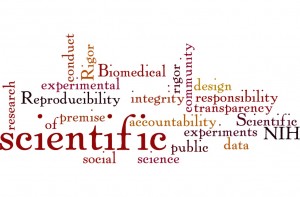By: Urmimala Basu
 Repeatability and reproducibility of scientific data has plagued scientists at all career levels for generations. Repeatability is the ability for experiments to be repeated with similar results when performed by the same experimenter, using the same instruments, under identical conditions and performed within a short period of time. Reproducibility is the extent that the new results agree with the initial experiments when performed by a different experimenter working under similar conditions, but performing experiments independently. While researchers are constantly chivied by their advisors to repeat the same experiments ‘just to be sure’, this practice undeniably slows down the pace of research. However, these laborious and essential steps cannot be done away with.
Repeatability and reproducibility of scientific data has plagued scientists at all career levels for generations. Repeatability is the ability for experiments to be repeated with similar results when performed by the same experimenter, using the same instruments, under identical conditions and performed within a short period of time. Reproducibility is the extent that the new results agree with the initial experiments when performed by a different experimenter working under similar conditions, but performing experiments independently. While researchers are constantly chivied by their advisors to repeat the same experiments ‘just to be sure’, this practice undeniably slows down the pace of research. However, these laborious and essential steps cannot be done away with.
There has been an increased awareness of this pressing problem of transparency in research
The last decade has seen a spiraling rise in the trend where papers published in high impact journals had to be retracted due to the inability of other researchers to replicate the reported results. While discrepancies in research published in papers are often unintentional, many arise due to poor experimental design and subsequent analysis. Uncomfortable as it may be for the research community and undoubtedly dangerous for biomedical research, significant portions of these studies can occasionally be cases of forgery. The most infamous example of such forgery was the claim that ordinary body cells could be reporgrammed to a pluripotent state solely by being exposed to a simple stimulus. This was a paradigm shifting concept to be sure as claimed in a pair of Nature papers in 2014. However, very soon this concept of “stimulus-triggered acquisition of pluripotency” was challenged and the authors were accused of falsifying and fabricating data. Undoubtedly this was the most notorious research scandal of our time, followed closely by the infamous Alexis Carell and his immortal chicken cells affair. Both of these incidents shook the scientific community to the core questioning the very canonical and fundamental practices of rigor and reproducibility (Read more about the immortal chicken cells and the stem cell debacle here).
There has been an increased awareness of this pressing problem of transparency in research; journals and funding agencies across U.S. and the world are becoming more conscientious. Pain-staking measures are being implemented to make the scientific community more cognizant of the importance of transparency in research and to boost the credibility of scientific practice as a whole.
Recently, the NIH has published comprehensive and stringent guidelines that need to be adhered to while preparing NIH grant applications and progress reports. The scientific premise, experimental design, use of biological variables and key biological/chemical resources and statistical analyses need to be mentioned as per these new guidelines. Team leaders are encouraged to be rigid and anal about implementing these principles in their labs. This NIH rubric, meant to increase transparency of scientific data, might seem like added load to the already elaborate and protracted processes of grant writing, but these steps will surely go a long way in making biomedical research more accountable and accessible to the public.
The original NIH guidelines on rigor and reproducibility can be accessed here.